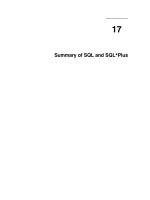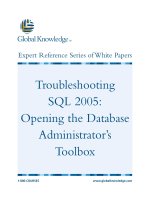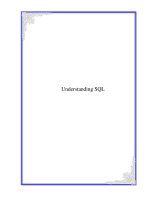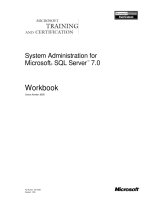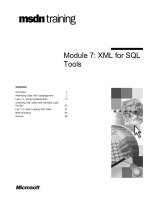Tài liệu SQL Assignment
Bạn đang xem bản rút gọn của tài liệu. Xem và tải ngay bản đầy đủ của tài liệu tại đây (27.3 KB, 2 trang )
SQL Assignment
Please follow those steps:
1. Create 2 tables and insert data as follows:
Customers
CustomerID (Int) Name (nVarChar(50))
1 John Nguyen
2 Bin Laden
3 Bill Clinton
4 Thomas Hardy
5 Ana Tran
6 Bob Carr
Orders
OrderID (Int) CustomerID (Int) ProductName (nvarchar(50)) DateProcessed (datetime)
1 2 Nuclear Bomb ‘2002-12-01’
2 3 Missile ‘2000-03-02’
3 2 Jet-1080 ‘2004-08-03’
4 1 Beers ‘2001-05-12’
5 4 Asian Food ‘2002-10-04’
6 6 Wine ‘2002-03-08’
7 5 Milk ‘2002-05-02’
Constraints
a. Apply the Primary Key Constraint for the “ID” columns of the 2 tables
b. Apply the Foreign Key Constraint in the Orders table.
c. Apply the Check Constraint to the DateProcessed column so that the date is
within ‘1970-01-01’ – ‘2005-01-01’
d. Apply Unique Constraint to the CustomerName column of Customers
2. Create a new table called “Processed Orders” and populate the new table with the data
selecting from Orders table Where DateProcessed is earlier than ‘2002-10-05’.
3. Create a view named vw_All_Orders that merges the two data set from Orders and
ProcessedOrders into one data set. Show all the orders in 2 tables.
4. Create a view named vw_Customer_Order that shows all the orders with the following
colums:
OrderID,CustomerName,ProductName,DateProcessed,Status
Business rules:
If CustomerName is a null value “New Customer” is returned
If DateProcessed is later than current date return “Pending”, if DateProcessed is
ealier return “History” in Status colum.
Tips:
a. Using Case When ...Then statement in the view
b. Using Getdate() function to get the current date time
5. Create a stored procedure named sp_Order_by_Date that accepts a date and returns all
the orders processed on that date.
The result of the query must be displayed in the following format :
OrderID
CustomerName ProductNameDateProcessed
(Hints: Based on the data supplied and your knowledge about various kind of joins guess the
results then after each select compare it with your guessing to check if what you understand is
correct. You also use As keyword or alias in the queries)
6. Create a DELETE trigger named trg_Delete_Order_Audit to audit the deletion of Orders
table.
Tips: Create an audit table “aud_Orders” with the same colums as in the Orders table and
1 more colum AuditDateTime (which will record the date time of deletion).


